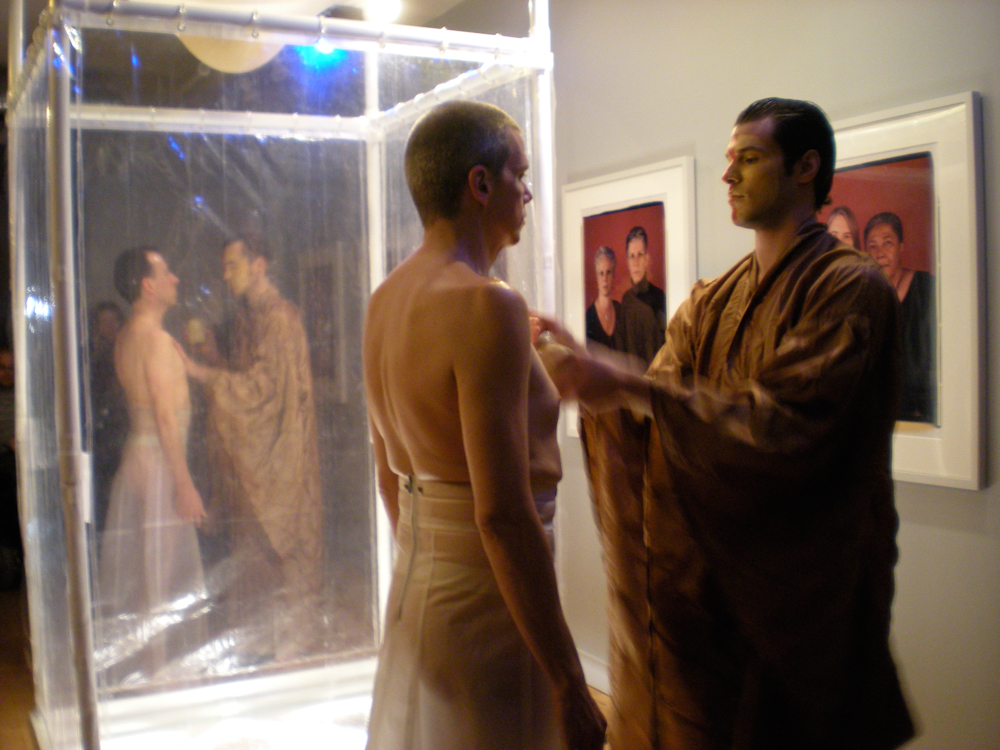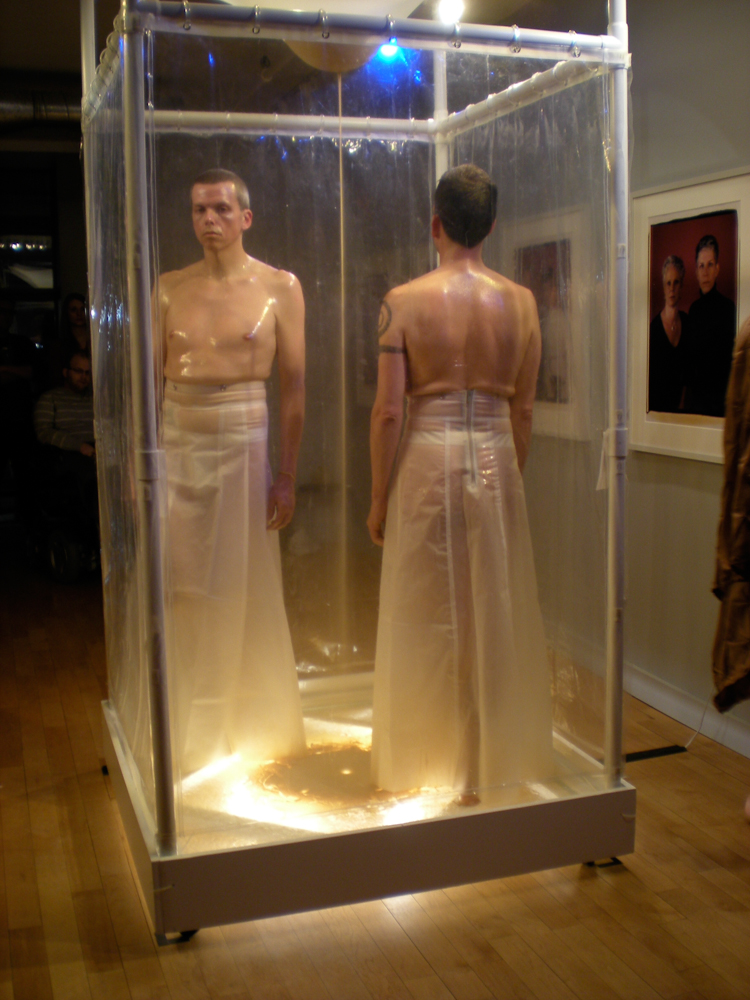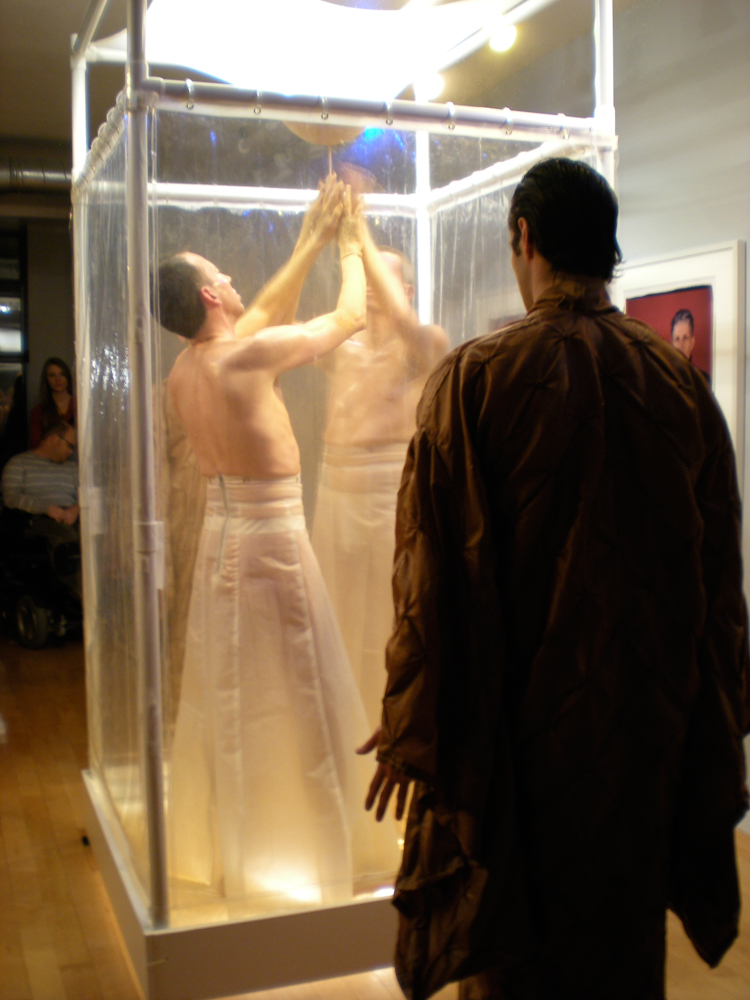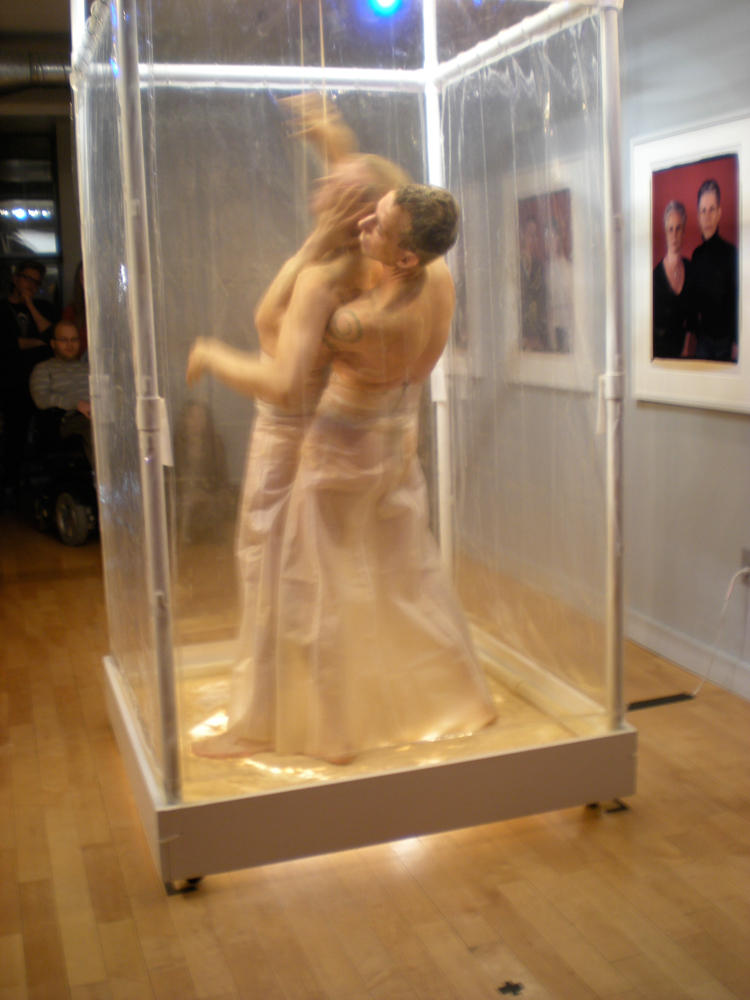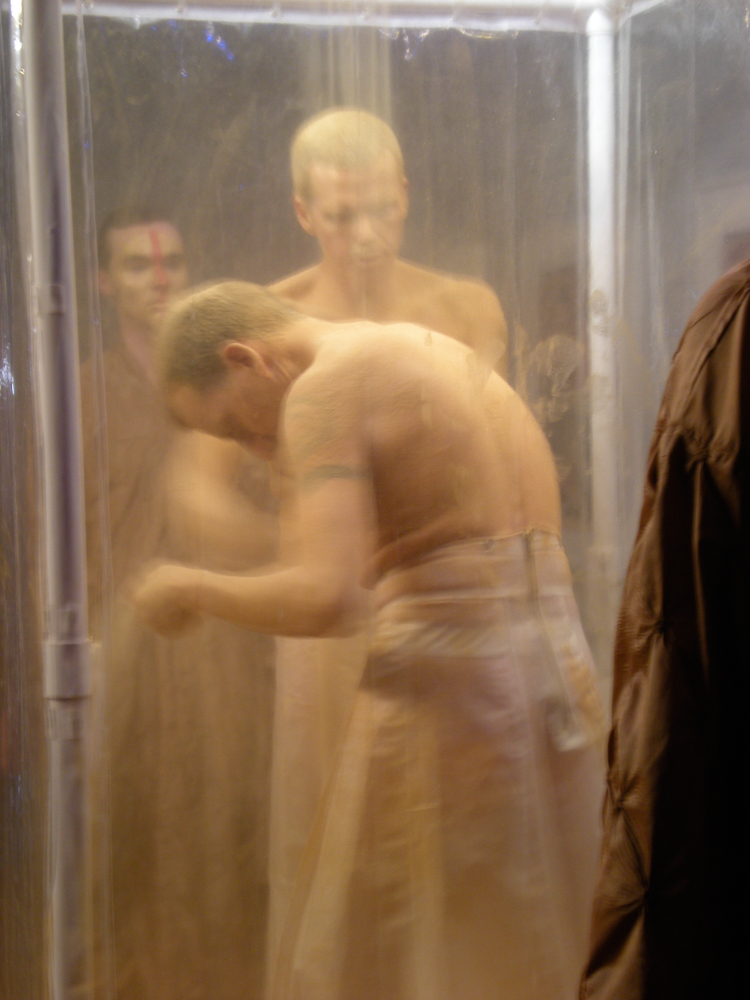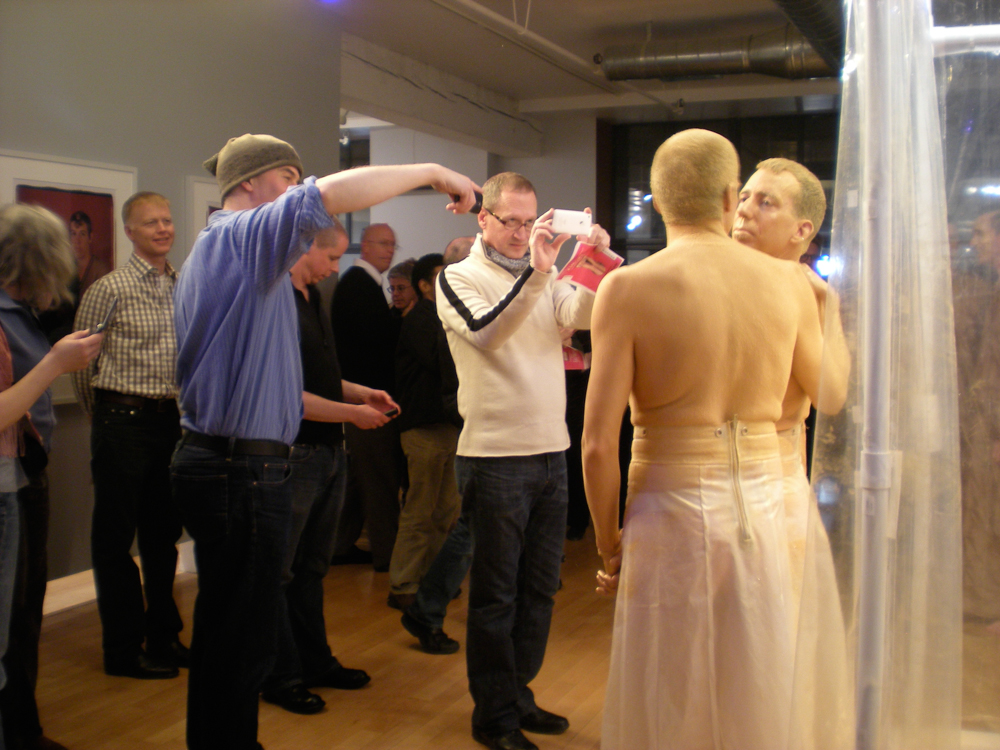Q&A: TT Baum and Michael Grohall
By Jess T. Dugan
TT Baum is an interdisciplinary artist who founded the performance art series EFFECTUS. His most recent work uses performance and installation; he includes painting, sculpture and new media in his repertoire. Michael Grohall is a writer, integrative massage therapist and activist. Interested in social transformation, he believes that “based on inertia, nothing is given to changing on its own, such as perceptions of same-sex marriage." Jess T. Dugan spoke with them about the performance art piece The WEDLOCK Project.
Jess T. Dugan: What are your backgrounds and how did you decide to begin The WEDLOCK Project?
TT Baum: I am interdisciplinary artist and Michael is a writer, artist, and activist. We wanted to get married in a way that celebrated who we are as people. After proposing to one another, we decided that we were in rich artistic territory and, a couple of years and several grant proposals later, we found ourselves with a year-long project.
JTD: Could you tell me a little bit about the 3 distinct parts and why you decided to organize it this way, over the course of a year?
Michael Grohall: Originally we wanted to create a performance piece out of our wedding and simply call itWEDLOCK. As we spent more time conceptualizing, WEDLOCK developed into 3 parts: ENGAGEMENT, PDA (Public Displays of Acceptance), and MATRIMONY. Because of the amount of time it would take to create and stage each part, we realized this was going to be a year-long endeavor beginning with our legal wedding in August 2009 and ending with our spiritual union in August 2010.
Together the three parts form a narrative of "the Romeos" (created out of our own autobiographical experience as gay men in love). In turn each piece confronts perceptions about same-sex marriage and relationship within different social groups. For example, ENGAGEMENT specifically addressed straight society’s perceptions of the GLBT experience of legalized marriage. PDA raises visibility for same-sex public displays of affection in public as well as confronting stereotypes. MATRIMONY reimagines traditional wedding rituals for same-sex couples.
JTD: I saw your first performance at Space 242 and was incredibly moved by it. How do you begin to create a piece like that, and how does it change through collaboration with each other and ultimately, collaboration with other performers and/or the audience and general public?
TT: Just like anything else that we create we have the concept of what we are trying to get across with the piece. In that case we were telling the story of the characters – The Romeos – and introducing them to the audience. We knew we wanted these two characters poised against a larger, potentially menacing group. Pieces like that go through many incarnations before the audience sees what they see, for instance ROMEOSbegan as a much more formal rigid piece with upwards of 20 performers. The other performers always add their experience and problem solving to the piece too. And though we have our final live performance—and an intention of how that will read—it changes with the audience being present and will continue to change as we get feedback after a performance.
JTD: Could you talk a little bit about the PDA experience and what that has been like? Have you had any surprises or discoveries that you weren’t expecting?
MG: PDA (Public Displays of Acceptance) performances have been very rewarding. It is a piece created to confront our fears as gay and lesbian members of society and to create an alliance with people in our life who are straight. Watching same-sex couples walking around a public space holding hands where one person in gay and the other straight can blow your mind if you think about our social conditioning.
One thing we have found surprising is how many gay/lesbian people are not sure who they could ask to be their ‘straight” counterpart for the performance. We have challenged people to consider why they cannot think of anyone to invite. We have also been intrigued by how often it is the straight-identified person who is more comfortable holding hands in public than the gay participant. We think being in the majority population has instilled a confidence that gay men and lesbians are still reaching for.
JTD: Do you feel a responsibility as gay artists to create socially relevant work, such as this project, or was it motivated more personally?
TT: We feel that as gay artists – our experience as human beings always informs our work. Just the fact that we are gay and creating art in some ways makes it socially relevant, because it introduces the public to ideas and perspectives that they normally wouldn’t think about. Specifically, with the WEDLOCK project (though it started as a very personal series of pieces, and still is in many ways) we ultimately feel that we DO have a responsibility to use our marriage experience as a platform for making art.
JTD: Gay marriage is a controversial subject throughout the country, but there is also a divide within the GLBT community, specifically in more liberal areas such as Massachusetts, about the importance of fighting for marriage rights (or not). Have you found that this divide informs the creation or reception of your work?
TT: The differing opinions within the GLBT community have definitely made it important for us to make theWEDLOCK project a reality. It’s part of the reason why the sub-title of the project is “confronting perceptions of same-sex marriage.” We aren’t just addressing perceptions and beliefs among straight people. We have had some cold shoulders within the GLBT community, but that pales in comparison to people who actually receive the work and think about their own views after having experience part of the Project.
JTD: How has the reality of the project been different from your expectations?
MG: The Project so far has been much more work than I think either of us realized at first. That said, it has amazed us both how much support we have received from other people.
We originally thought that a project of this scope and complexity, which tackled a very current social issue, would be a great candidate for a grant. So far that has not been the case but we continue to research grants and sponsorship.
JTD: What has been the most rewarding aspect of the project thus far?
TT: For us the most rewarding aspect of the project has been that we get to create together. As two creative people with very different ways of working sometimes, it is fantastic to see how our strengths dovetail into making things happen. It has also given us a great sense of community to be able to use our marriage experience in a public way.
MG: Also it has allowed us to come out in an entirely different way. Being legally married makes us feel like we are equal citizens. I want people to know that TT is my husband and I want to be able to interact like a couple everywhere we go. Through the characters of the Romeos, we have been able to be out in society in a way that I hadn’t let myself experience before.
JTD: As an artist working in performance, among other things, have you had difficulty finding spaces to show your work and/or gallery representation? What do you perceive to be the challenges for artists working in media that is not easily sellable?
TT: Finding spaces to show performative and new media work has always been challenging, especially in Boston. Galleries are very excited about the idea of showcasing performance work, but gallerists don’t know what to do with us because our work is not sellable, and they have no experience with charging a door fee for admission. I have been lucky with the Project and my other work that I am able to show at least once a year or so. The biggest challenge with performance and new media is funding. Since the work is often not self-sustaining, most of the cost is personally funded by the artist. In my case, I work a lot.
JTD: What are your plans for the rest of the project and beyond?
MG: We would really like to take WEDLOCK beyond Massachusetts. Last year we got the chance to perform with Annie Sprinkle and Beth Stephens in a piece from their Love Art Laboratory. Hopefully the four of us can collaborate on some same-sex marriage work. We are looking at taking PDA to cities and towns in states where same-sex marriage is still illegal, and we are planning a book about the project as well as an evening length show that takes pieces from each part of the first year.
Editor's note: this interview was originally published on April 13, 2010 on Big, Red, & Shiny. "SHOWER" was performed March 26th, 2010 at Gallery Kayafas, located at 450 Harrison Ave, Boston, MA during the exhibition Coupled by Jess T. Dugan (March 4-April 10, 2010).
All images © TT Baum, Michael Grohall, and Jess T. Dugan

